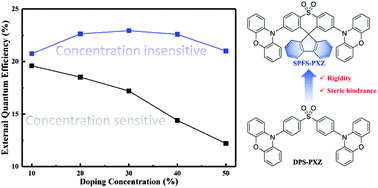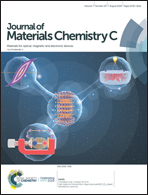Thermally activated delayed fluorescence emitters with low concentration sensitivity for highly efficient organic light emitting devices†
Abstract
Thermally activated delayed fluorescence (TADF) emitters normally suffer from serious concentration sensitivity, realizing peak electroluminescence efficiencies with precise control of the doping concentrations, which may hinder their practical applications in organic light emitting devices (OLEDs). In this work, we developed TADF emitter 2′,7′-di(10H-phenoxazin-10-yl)spiro[fluorene-9,9′-thioxanthene]10′,10′-dioxide (SPFS-PXZ) based on conventional TADF emitter 10,10′-(sulfonylbis(4,1-phenylene))bis(10H-phenoxazine) (DPS-PXZ). By introducing a fluorene group, the molecular rigidity and steric hindrance of SPFS-PXZ are improved greatly, which contributes to suppressing the strong π–π stacking tendency between phenoxazine segments and reduces intermolecular interactions. In turn, SPFS-PXZ successfully exhibits low concentration sensitivity in OLEDs, and keeps high maximum external quantum efficiencies (EQEs) over 20.8% with a small EQE fluctuation of 2.1% in a wide doping concentration range from 10 wt% to 50 wt%. These results prove that SPFS-PXZ is an ideal model to develop efficient TADF emitters with low concentration sensitivity.

- This article is part of the themed collection: Editor’s Choice: Spiro compounds for electronics


 Please wait while we load your content...
Please wait while we load your content...